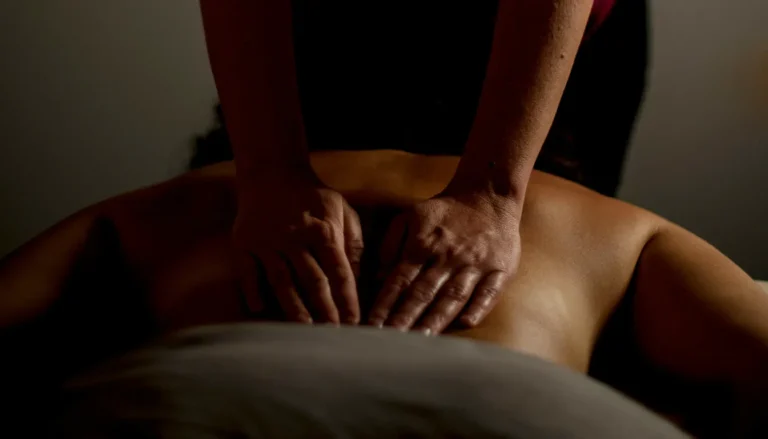Feeling overwhelmed is common in everyday life, and many people in the UK turn to massage and other therapy options to support their health and wellbeing.
The central question is simple: can a massage change measurable markers so the body feels calmer right away and over time? A comprehensive review of 25 peer‑reviewed studies (typical sessions: 20–30 minutes, twice weekly for around five weeks) shows consistent immediate falls in salivary cortisol and heart rate after a single session.
Those quick dips often come with a clear sense of relaxation in the body and mind. However, longer‑term changes in physiological markers are more mixed. Some trials report improvements in diastolic blood pressure, while measures such as urinary cortisol and catecholamines tend not to change much.
Massage is best seen as supportive rather than a cure for anxiety.
This guide will explain the science plainly, outline common therapy types, describe a typical session, note who should be cautious, and suggest how to fit treatment into busy life in the UK.
Key Takeaways
- Immediate effects: one session often lowers cortisol and heart rate and feels calming.
- Long‑term physiological changes are inconsistent across studies.
- Some evidence shows diastolic blood pressure may improve in certain groups.
- Treatment is supportive; combine with sleep, breathing and other habits for best results.
- Individual response varies — try a session with a trained professional to assess personal benefit.
Quick answer: what we know right now
Research shows a single session often brings a clear, measurable calming response. Across 25 peer‑reviewed trials, one appointment commonly produced immediate falls in salivary cortisol and lowered heart rate, usually after a 20–30 minute session.
Key takeaways at a glance
- Immediate benefit: measurable drops in cortisol and pulse after one visit.
- Most studies used short sessions twice weekly for about five weeks.
- Longer‑term gains across multiple treatments were promising but mixed.
- Some trials found modest improvements in diastolic blood pressure after a course.
- Urinary cortisol and catecholamine levels often stayed unchanged.
- Consider trialling a few sessions and tracking personal responses.
Where evidence is strong vs still emerging
The strongest evidence supports fast, short‑term effects you can feel and measure right after a session. That makes massage therapy a useful option for immediate relief of symptoms linked to anxiety and everyday tension.
Evidence for lasting physiological change across weeks is less consistent. Outcomes depend on protocol, timing of samples and which markers researchers measure. See this as a supportive therapy alongside other healthy habits.
Do massages reduce stress: the science in brief
Simple, short appointments tend to produce measurable calming signals in the body. In nine studies that checked salivary cortisol at the first session, eight reported clear immediate falls. Heart rate also dropped after a single appointment, matching how most people describe feeling—calmer and more settled.
Acute effects: cortisol and heart rate after a single session
After one massage session, salivary cortisol typically falls and pulse slows. These changes are immediate and most obvious just after treatment. The timing of sampling matters; we do not always know how long the lower levels last through the rest of the day.
Longer-term effects: what multiple treatments show
Across multi‑week trials the picture is mixed. Three of nine studies reported lower urinary cortisol, but two had baseline differences and one used daily sessions over 22 days. Some research found modest diastolic blood pressure gains, while many trials showed no sustained hormonal change.
Why results vary between studies
Study heterogeneity partly explains variation: session length ranged from 5–90 minutes, frequency varied, populations differed (healthy adults to clinical groups), and sampling times were inconsistent. That makes direct comparison hard.
Practical point: repeated short‑term benefits can still matter. Track perceived calm, sleep and mood after each session to see if effects add up for you. If you want immediate relief, a single visit is often worthwhile; for lasting physiological shifts, try consistent scheduling alongside other therapy and healthy habits.
How massage affects your nervous system
When the body senses a threat it triggers a fast chain of physical reactions that prepare you for action. This starts in the nervous system and the HPA axis, which release a hormone cascade including epinephrine and cortisol.
From stress response to relaxation response
The sympathetic branch raises heart rate, quickens breathing and mobilises energy. That response helps when you need a short burst of effort.
Massage therapy and gentle touch encourage the parasympathetic side. This is the “rest and digest” part that slows respiration and lowers pulse.
What that means for breathing, rate and perceived calm
After a short session you may notice slower breathing, a gentler heart rate and a lighter mental state. Many studies show immediate dips in salivary cortisol and pulse after one visit.
Other markers, such as urine catecholamines, often stay the same over weeks. That suggests the main benefit is an immediate nudge toward balance rather than a permanent reset.
Tip: focus on steady breathing during massage or massage therapy to boost the parasympathetic shift and make the calming effects more noticeable.
| Sign | Sympathetic effect | Parasympathetic / massage effect |
|---|---|---|
| Breathing | Fast, shallow | Slower, deeper |
| Heart rate | Elevated | Reduced |
| Mental state | Alert, tense | Clear, settled |
Evidence-backed benefits you may feel today
Many people notice real, measurable calm within minutes of a hands‑on session. Short appointments in trials were usually 20–30 minutes on a table, and effects after one visit were consistent across studies.
Lower salivary cortisol straight after a session
In eight of nine studies, salivary cortisol fell immediately following the first massage session. That biochemical drop matches how participants describe feeling: less tense and more settled.
Reduced heart rate and a calmer state
Heart rate consistently reduced acutely post‑treatment, producing a noticeable calming state. Many people report a clearer head and softer breathing within minutes of getting off the table.
Easing muscle tension in the neck, shoulders and back
Hands‑on work commonly targets the neck, shoulders and back. This helps muscles to stop guarding, lengthen and relax, easing local tightness and improving comfort in the body.
- Expect an immediate drop in cortisol and a steadier heart rate after one session.
- Short appointments (20–30 minutes) can deliver real benefits when time is limited.
- Pair in‑session relaxation with slow nasal breathing to strengthen the nervous system shift.
- Allow a short, quiet window after treatment and follow with gentle movement and hydration.
- Repeating sessions tends to reproduce the same immediate relief, useful during high‑pressure spells.
Benefits that may build over time (with caveats)
With repeated appointments, certain physiological measures may move in a positive direction. Evidence is promising in places, but not uniform across studies, so expectations should stay realistic.
Blood pressure: some evidence for diastolic improvements
Several trials show modest falls in diastolic blood pressure after a course of sessions over weeks. These changes, when present, can support cardiovascular health and lower long‑term pressure risk factors.
Mood and anxiety: feeling more balanced
Even when hormone levels like urinary cortisol stay unchanged, many people report clearer mood and less day‑to‑day anxiety or depression symptoms.
Perceived calm can improve daily functioning and make tasks easier, which is a real benefit even if lab markers do not shift much over time.
Sleep quality and deeper rest
Better relaxation in the evening often helps people fall asleep more easily and wake feeling more restored. Improved sleep can then amplify other gains in mood and resting heart rate.
Try a weekly session for a month before judging long‑term effects. Track simple markers such as sleep quality, headaches, perceived tension and resting pulse (wearables help). Pair ongoing therapy with sleep hygiene and gentle exercise for best results.
| Outcome | Short‑term effect | Possible change over time |
|---|---|---|
| Diastolic blood pressure | Often unchanged after one session | Modest reductions after multiple sessions in some studies |
| Hormone levels (urine cortisol) | Immediate salivary falls common | Mixed evidence for lasting urinary change |
| Catecholamines | Little change acutely | Generally unchanged across trials |
| Mood & sleep | Noticeable calm and easier sleep after one visit | Improved sleep and mood reported with consistent sessions |
For more detail on trial methods and outcomes, see a systematic review. If you have existing health concerns that affect pressure or heart rate, consult a clinician before starting regular therapy.
What the research says (and what it doesn’t)
Timing and method often decide whether a trial finds a clear effect or not.
Cortisol: saliva vs urine and why timing matters
Salivary cortisol captures quick, short‑term changes. Studies commonly report an immediate fall in saliva after a single session. That makes salivary sampling useful for measuring momentary calm.
Urinary cortisol reflects a longer window. Over weeks, urine measures tended to show mixed or no clear change unless studies used intensive daily protocols. This difference explains conflicting headlines about the same hormone.
Catecholamines (adrenaline/noradrenaline): largely unchanged in studies
Urine measures of catecholamines across seven trials mostly stayed the same. That suggests limited change in this pathway over several sessions.
One study in Parkinson’s disease reported divergent results, which shows population differences matter. Overall, the evidence points to small or no sustained shifts in adrenaline or noradrenaline in typical trials.
Study design limits: sample sizes, protocols and consistency
Many trials used 20–30 minute sessions twice weekly, but designs ranged from 5 to 90 minutes and 1 to 22 treatments. Small samples and varied sampling times make direct comparison hard.
Practical point: immediate salivary falls are reliable, while longer‑term laboratory changes are less certain. Value how you feel after a session but be realistic about long‑term lab numbers.
| Measure | Typical short‑term finding | Typical long‑term finding |
|---|---|---|
| Salivary cortisol | Immediate fall after one session | Not applicable (short‑window measure) |
| Urinary cortisol | Often unchanged acutely | Mixed; occasional falls with intensive daily protocols |
| Catecholamines (urine) | Little change | Generally unchanged across studies |
| Other markers | Heart and blood pressure often fall briefly | Modest diastolic BP change in some trials |
- Standardise session length and sampling times in future trials to sharpen conclusions.
- Consider both subjective benefit and objective markers when assessing treatments.
Types of massage for stress relief
Different styles of hands‑on work suit different aims, from deep relaxation to targeted recovery. Below are common options you will meet in UK clinics and what each tends to offer.
Swedish and holistic approaches
Swedish and holistic massage use long, flowing strokes and gentle kneading to calm the nervous system. These techniques target common areas such as the neck, shoulders and back to ease tension and promote rest.
Thai massage
Thai massage blends assisted stretches with rhythmic pressure and acupressure. It can open the chest, improve posture and support better breathing, useful after long days at a desk.
Deep tissue and sports options
Deep tissue and sports massage apply firmer pressure to break down long‑standing tightness. They suit people whose muscles form stubborn knots or who need help with recovery and performance.
Soft tissue therapy and myofascial work
Soft tissue therapy combines passive and active techniques to address muscle and fascial patterns. Methods include neuromuscular trigger‑point work, myofascial release and muscle energy technique to coordinate breath and movement.
- Match the style to your aim: choose deep relaxation, chronic tension relief or improved movement.
- Therapists can adapt pressure and pace, so firmer work can still feel calming.
- Be clear about preferences and sensitive areas before treatment to tailor the session.
Inside a massage session: what to expect
A typical appointment begins with a short chat to match treatment to your current needs. The therapist will ask about medical history, recent aches and which areas you want them to focus on.
Consultation, pressure preferences and focus areas
Before hands‑on work starts you will agree pressure and privacy choices. Make it clear if you like firmer or gentler touch; therapists check in during the session to stay comfortable.
Most UK trials used 20–30 minute table sessions, often twice weekly over a few weeks. Chair options are common for targeted, shorter visits.
Breathing, pacing and aftercare to extend the benefits
Steady breathing helps the nervous system respond and eases muscle guarding. Expect a calm opening, focused work on priority spots and a soothing finish to support a relaxed state.
Aftercare is simple: sip water, avoid intense workouts for a few hours and take a short walk. Light stretching later in the day can help preserve range of movement.
Practical tip: plan five to ten quiet minutes before your next meeting to keep the session’s positive effects on your body and mind.
| Stage | What happens | Typical length | Why it matters |
|---|---|---|---|
| Consultation | Medical history, goals, focus areas | 3–5 minutes | Personalises treatment and highlights warnings |
| Main work | Pressure on priority areas, pacing set to comfort | 15–25 minutes | Targets tight spots and promotes parasympathetic shift |
| Finish & aftercare | Soothing strokes, breathing cues, hydration advice | 2–5 minutes | Helps sustain immediate benefits and recovery |
| Formats | Table full‑body or chair for focused relief | Short to standard sessions | Choose by time, aim and convenience |
Safety, contraindications and who should be cautious
Before booking, a short health check helps spot when treatment needs adapting. Clinical research includes varied groups—people with hypertension, post‑operative patients, cancer or HIV‑positive cohorts and others—so protocols often change to suit individual needs.
High blood pressure, pregnancy and recent surgery
If you have high blood pressure, tell your therapist. Some studies show modest diastolic improvements, but care plans must align with your GP or specialist advice.
During pregnancy, consult a GP or midwife first. Seek a practitioner trained for each trimester and avoid deep work over the abdomen unless advised.
After surgery, wait until a clinician clears you. Therapists will modify positioning and avoid operated areas until wounds heal.
Other cautions and practical steps
- Avoid therapy with active infections, fever, acute injuries or unhealed wounds.
- Tell the therapist about medications such as blood thinners—these affect pressure choices.
- Report any unmanaged cardiovascular symptoms before treatment.
- Good practitioners will adapt pressure, positioning and session length to your health and comfort.
“Safety‑first practice helps you enjoy calming sessions with confidence.”
| Situation | Advice | When to seek medical clearance |
|---|---|---|
| High blood pressure | Inform therapist; light pressure and monitoring | Before starting regular sessions or if medication changes |
| Recent surgery | Avoid area; delay treatment until cleared | After surgical follow‑up confirms healing |
| Pregnancy | Use specialised prenatal practitioners | Check with GP/midwife each trimester |
| Blood thinners & medications | Disclose drugs; therapist adjusts techniques | Always, before first session |
If you feel unusual symptoms during or after a session—dizziness, chest pain or a severe headache—seek medical attention immediately. Clear communication and a safety‑first approach let you enjoy therapy with confidence.
Making massage work for you in the UK
Booking the right rhythm of appointments helps the short‑term gains stack up into steady improvement. Start by testing weekly massage therapy for three to four weeks to see if immediate benefits repeat and accumulate.
How often to book and align sessions with your needs
If your symptoms ease, shift to fortnightly or monthly maintenance. For flare‑ups, choose firmer, focused work; in busy periods prefer gentler treatment and breathing cues to support recovery.
- Protect your time: book early evening or late afternoon to avoid rushing and extend the calm.
- Choose qualified practitioners: check UK professional bodies and share health updates at each visit.
- Short appointments: 20–30 minute massage sessions can deliver meaningful immediate effects when time is limited.
- Bundle with routines: pair sessions with an evening wind‑down to prolong benefits.
- Track simple markers: sleep, mood and muscle comfort help tailor future treatments.
“Consistency, not intensity, often decides whether sessions feel truly helpful.”
| Plan | When to use | Why it helps |
|---|---|---|
| Weekly for 3–4 weeks | Initial trial period | Shows if benefits repeat and build |
| Fortnightly or monthly | Maintenance | Sustains gains with less time commitment |
| Short targeted session | When time is limited | Delivers quick, measurable calming effects |
Complementary habits that amplify the effects
Small daily habits can magnify the immediate calm you feel after a session. Pairing hands‑on therapy with steady routines helps the nervous system stay in a quieter state for longer.
Breathing practice, sleep routines and gentle movement
Breathing is key: try slow nasal breaths for a few minutes each day to re‑engage the parasympathetic response between visits.
Keep a consistent sleep routine. Regular bedtimes, a cool, dark room and a tech‑free wind‑down help consolidate the relaxed state from your last massage.
Move gently. Short walks, yoga or Pilates ease stiffness, support posture and keep the body feeling fluid. Add brief desk breaks to reset posture and ease neck and shoulder tension.
- After a warm shower, do light stretches for areas that often hold pain.
- Hydrate and eat balanced meals to support recovery and steady energy across busy life.
- Use two minutes of quiet breathing before meetings to steady your mind.
Small, sustainable habits often make the benefits of massage therapy stress relief last longer. For simple guided relaxation ideas see relaxation techniques.
Conclusion
For many people, brief hands‑on treatment yields a swift physiological and mental easing. Trials consistently show immediate falls in salivary cortisol and a calmer state after a single session. These short gains are reliable and repeatable.
Longer‑term changes vary. Some people see modest diastolic blood pressure improvements with repeated sessions, while urinary hormone measures often stay the same. Expect mixed results and stay realistic about outcomes.
Pairing regular massage therapy with steady breathing practice, a sleep routine and gentle movement helps the benefits last longer. If your heart or blood health matters, discuss goals with your therapist and GP before booking a course.
Try a short series of sessions and track how your body and mind respond. The best measure is how you feel — more settled, comfortable and ready for what’s next.
FAQ
Do massages really help reduce stress and anxiety?
Many people report feeling calmer after a session. Short‑term benefits include lower heart rate, reduced muscle tension and a drop in salivary cortisol in several studies. Longer-term improvements in mood and anxiety are reported too, but results depend on frequency, type of treatment and individual differences.
What is the quick answer: what do we know right now?
Massage therapy can produce reliable short‑term relaxation effects. Evidence for sustained changes in hormones and blood pressure is promising but mixed. Regular sessions paired with good sleep and breathing work give the best chance of lasting benefit.
What are the key takeaways at a glance?
Expect immediate relaxation, reduced heart rate and eased muscle tension after a session. Cortisol often falls briefly. For persistent improvements in mood, sleep or blood pressure you usually need repeated treatments and complementary habits such as breathwork and movement.
Where is the evidence strong and where is it still emerging?
Strong evidence supports short‑term reductions in perceived anxiety, muscle tension and transient cortisol decreases. Evidence is still emerging for sustained hormone changes, long‑term blood pressure control and clear comparisons between massage styles due to small or varied study designs.
What happens to cortisol and heart rate after a single session?
Many studies show salivary cortisol falls after one session and heart rate commonly decreases, reflecting increased parasympathetic activity. The magnitude varies with session length, technique and individual baseline stress levels.
Do multiple massage sessions give better results?
Repeated sessions often produce more durable improvements in mood, sleep and chronic muscle pain. However, study designs vary, so frequency recommendations range from weekly to monthly depending on needs and condition.
Why do results vary between studies?
Differences arise from small sample sizes, inconsistent protocols, varied outcome measures (saliva vs urine cortisol), and participant differences such as health status, medication or baseline anxiety.
How does massage affect the nervous system?
Massage can shift the body from a stress‑driven state governed by the hypothalamic‑pituitary‑adrenal (HPA) axis to a relaxation response driven by the parasympathetic system. That shift helps lower heart rate, slow breathing and promote calm.
What does that mean for breathing and perceived calm?
When parasympathetic tone rises, breathing tends to slow and deepen, which supports feelings of relaxation and helps reduce physical symptoms of anxiety.
What evidence‑backed benefits might I feel immediately?
Many clients notice eased neck, shoulder or back tension, reduced heart rate, and a calmer mental state soon after treatment. Salivary cortisol often dips straight after a well‑delivered session.
Which benefits may build over time?
Over weeks or months, people may see modest improvements in diastolic blood pressure, steadier mood, less anxiety and better sleep. Consistency, good aftercare and combined lifestyle habits matter.
What does research say about cortisol measurements?
Timing and sample type matter: salivary measures show acute changes after sessions, while urine or blood measures can miss short‑lived shifts. That makes interpretation across studies tricky.
Do adrenaline or noradrenaline levels change with massage?
Most studies find little consistent change in catecholamines (adrenaline/noradrenaline). The main measurable effects tend to be on subjective calm, heart rate and cortisol.
Which types of massage are best for relaxation?
Swedish and holistic approaches are well suited for deep relaxation. Thai massage adds supportive stretching and breath‑linked movements. Deep tissue or sports work helps chronic tension but may feel more intense.
What can I expect during a session?
A therapist will take a brief consultation, check medical history and pressure preference, then focus on target areas. You’ll be guided on breathing and offered aftercare suggestions to extend the benefit.
Who should be cautious or seek medical advice first?
People with uncontrolled high blood pressure, recent surgery, active infection, deep vein thrombosis, certain skin conditions or pregnancy should consult a GP or specialist and tell the therapist before booking.
How often should I book sessions to get results in the UK?
For acute tension, a weekly session for a few weeks is common. For maintenance, fortnightly or monthly visits work for many. Tailor frequency to your symptoms, budget and response to treatment.
What complementary habits amplify massage effects?
Simple breathing practice, consistent sleep routines, gentle movement (walking or yoga) and hydration all help prolong relaxation, reduce muscle tension and support mood.





